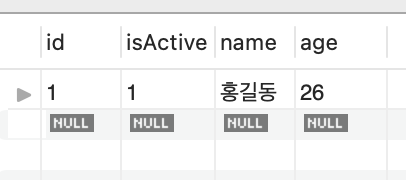데이터베이스 연동을 위해 @nestjs/typeorm 패키지를 설치한다.
(mysql2 인것은 promise를 지원하기 때문이라고 한다. 그냥 mysql은 promise-mysql을 따로 설치해야한다고 한다.)
npm install --save @nestjs/typeorm typeorm mysql2
.env 파일에 DB 관련 정보를 입력하고 AppModule에 TypeOrmModule을 import 해준다.
// app.module.ts
import { Module } from '@nestjs/common';
import { AppController } from './app.controller';
import { AppService } from './app.service';
import { UserModule } from './user/user.module';
import { TestModule } from './test/test.module';
import { ConfigModule } from '@nestjs/config';
import { TypeOrmModule } from '@nestjs/typeorm';
import { ConfigurationModule } from './config/config.module';
@Module({
imports: [
UserModule,
TestModule,
ConfigurationModule,
TypeOrmModule.forRoot({
entities: ['dist/**/**.entity{.ts,.js}'],
type: 'mariadb',
host: process.env.DB_HOST,
port: parseInt(process.env.DB_PORT),
username: process.env.DB_USERNAME,
password: process.env.DB_PASSWORD,
database: process.env.DB_DATABASE,
synchronize: true,
logging: true,
}),
],
controllers: [AppController],
providers: [AppService],
})
export class AppModule {}
// config.module.ts
import { Module } from '@nestjs/common';
import { ConfigModule } from '@nestjs/config';
import * as Joi from 'joi';
@Module({
imports: [
ConfigModule.forRoot({
isGlobal: true,
envFilePath: '.env',
validationSchema: Joi.object({
DB_HOST: Joi.string().required(),
DB_PORT: Joi.string().required(),
DB_USERNAME: Joi.string().required(),
DB_PASSWORD: Joi.string().required(),
DB_DATABASE: Joi.string().required(),
}),
}),
],
})
export class ConfigurationModule {}
Entity?
Entity is a class that maps to a database table (or collection when using MongoDB). You can create an entity by defining a new class and mark it with
즉, 데이터베이스 테이블에 매핑되는 클래스이다. 엔티티를 만들면 데이터베이스에 자동으로 클래스에 일치하게 테이블이 생성된다.
synchronize
Setting synchronize: true shouldn't be user in production. otherwise you can lose production data.
이 옵션을 true로 둔다면 자동으로 테이블을 엔티티와 동기화해주기 때문에 테이블을 날리고 다시 만든다.
user.entity.ts 라는 폴더를 만들어 @Entity() 데코레이터를 가지는 User 클래스를 만든다. User 테이블에 들어갈 컬럼들을 정의한다.
Primary Column을 정해주지 않으면 해당 오류가 나온다.
[Nest] 1824 - 2023. 02. 15. 오후 10:34:38 ERROR [ExceptionHandler] Entity "User" does not have a primary column. Primary column is required to have in all your entities. Use @PrimaryColumn decorator to add a primary column to your entity.
// user.entity.ts
import { Column, Entity, PrimaryColumn } from "typeorm";
@Entity()
export class User {
@PrimaryColumn()
id: number;
@Column()
firstName: string;
@Column()
lastName: string;
@Column({ default: true })
isActive: boolean;
}

생성한 entity를 사용하기 위해 모듈에 forFeature()를 사용하여 import 해준다.
// user.module.ts
import { Module } from '@nestjs/common';
import { TypeOrmModule } from '@nestjs/typeorm';
import { UserController } from './user.controller';
import { User } from './user.entity';
import { UserService } from './user.service';
@Module({
imports: [TypeOrmModule.forFeature([User])],
controllers: [UserController],
providers: [UserService],
exports: [UserService],
})
export class UserModule {}
nestjs에서 제공하는 repository 패턴을 이용해 쉽게 CRUD를 구현할 수 있다.
서비스단의 생성자 부분에서 @InjectRepository() 데코레이터를 이용해 의존성 주입을 해줘야한다.
앞의 forFeature()로 넣어준 Entity의 속성으로 주입을 해준다.
// user.service.ts
import { Injectable } from '@nestjs/common';
import { InjectRepository } from '@nestjs/typeorm';
import { Repository } from 'typeorm';
import { User } from './user.entity';
@Injectable()
export class UserService {
constructor(
@InjectRepository(User)
private readonly repository: Repository<User>,
) {}
async create(name: string, age: number) {
const user = this.repository.create({
name,
age,
});
return this.repository.save(user);
}
findAll(): Promise<User[]> {
return this.repository.find();
}
findOne(id: number): Promise<User> {
return this.repository.findOneBy({ id });
}
getHelloUser(name: string): string {
return `hello ${name}~`;
}
}
repository.save()를 사용해 DB 에 insert 해준다.
.create()는 단순히 DB에 들어갈 데이터를 만들어 주는 기능을 해준다.
컨트롤러에 Post로 경로를 하나 만들어 주고 api를 호출 한다.
// user.controller.ts
@Post()
create(@Body() userDto: UserDto): Promise<User> {
console.log(userDto);
return this.userService.create(userDto.name, userDto.age);
}


만약 이런 Incorrect string value: '\xED\x99\x8D\xEA\xB8\xB8...' 오류가 나온다면 해당 테이블의 charset 을 재설정 해주면 된다.
alter table User convert to character set utf8;


'dev > nestjs' 카테고리의 다른 글
| nestjs 프로젝트 생성 시 오류 (Failed to execute command: npm install --silent) (0) | 2023.11.01 |
|---|---|
| FileFieldsInterceptor (0) | 2023.03.16 |
| 인터셉터 (0) | 2023.02.14 |
| HTTP module (0) | 2023.02.13 |
| 환경 변수 (0) | 2023.02.12 |

